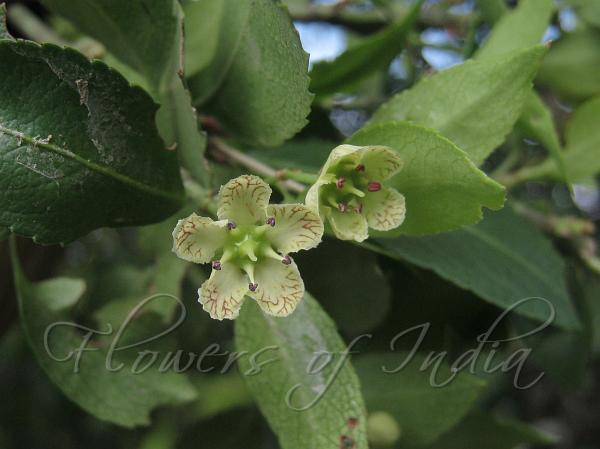|
| Purple-Veined Spindle Tree |
|

|

| File size | 369520 |
| Original date | 5/1/12 9:25 AM |
| Resolution | 2048 x 1536 |
| Flash | Flash did not fire, auto |
| Focal length | 6.6mm |
| Exposure time | 1/640s |
| Aperture | 3.0 |
| Focus Distance | |
| Metering Mode | Center weighted average |
| Camera make | Canon |
| Camera model | Canon PowerShot A495 |
| Sensor type | OneChipColorArea |
|
|
|
|
Photo: |
Botanical name: Euonymus tingens Family: Celastraceae (Spike-thorn family)
Purple-Veined Spindle Tree is an evergreen shrub to
small tree, 2-8 m tall. Branches are gray-black to gray-brown, round,
sturdy, twigs greenish, with channels. Leaf-stalks are 3-5 mm, leaves
thickly leathery, elliptic or oblong-elliptic, 4-6 × 2-2.5 cm, base
wedge-shaped or round, margin toothed, tip blunt or pointed. Lateral
veins are 8-12 pairs, curving forward and disappearing before reaching
margin. Flowers are borne in severla flowered clusters on stalks
1.5-3.5 cm long. Flower-stalks are 0.5-2 cm long. Flowers are 5-merous,
about 1.5 cm in diameter, sepals semicircular, petals creamy white with
strong purplish veins around edges, round to obovate. Capsule are
obovoid-spherical, 5-angled, pinkish or reddish when fresh, brown or
yellow-brown to red-brown when dry, 1.2-1.3 × 1.2-1.4 cm. Seeds are
ellipsoid, dark brown, partially covered by orange aril. Purple-Veined
Spindle Tree is found in the Himalayas, from Himachal Pradesh to SW
China and Burma, at altitudes of 1300-3300 m. Flowering: April-August.
Medicinal uses: The bark of the tree is
purgative. The juice of the bark is used in the treatment of eye
diseases and is also of benefit in cases of chronic constipation and
dyspepsia.
The bark of the tree is
purgative. The juice of the bark is used in the treatment of eye
diseases and is also of benefit in cases of chronic constipation and
dyspepsia.
Medicinal uses:
 The bark of the tree is
purgative. The juice of the bark is used in the treatment of eye
diseases and is also of benefit in cases of chronic constipation and
dyspepsia.
The bark of the tree is
purgative. The juice of the bark is used in the treatment of eye
diseases and is also of benefit in cases of chronic constipation and
dyspepsia.
| Identification credit: Krishan Lal | Photographed in Sirmaur Distt, Himachal Pradesh & Dhanaulti, Uttarakhand. |
• Is this flower misidentified? If yes,